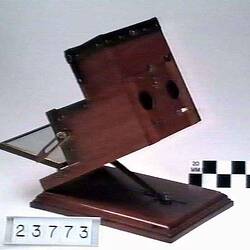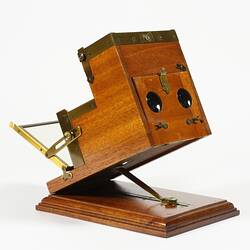Summary
Krõmskõp viewer used to view kromograms to produce a colour image. These were the World's first colour images; the images were not fixed and could only be seen through the viewer.
The Kromskop, was invented by the United States citizen, Frederic Ives (1856-1937) and first marketed in 1895.
The Kromskop is a stereoscopic viewer which combined the images from six black and white transparencies through colour filters to creat a stereoscopic colour image. The six black and white transparencies were connected together in such a way that they could be 'draped' over the viewer. The set of six transparencies is called a Kromogrram.
The stereo viewer has three 'external' filters red, blue and green plus two internal filters of cyan and green plus a mirror in the front to angle the light entering the viewer.
The viewer can also be raised and angled towards the light.
The black and white stereo glass photos - Kromograms - come in sets of three pairs and were taken simultaneously with a special camera through three sets of coloured filters (blue, red and green).
The six black and white transparencies were connected together in such a way that they could be 'draped' over the viewer.
This has the effect of 'reassembling the colour image' when viewed through the viewer. The three sets of images are superimposed; the light passing the combination of colour filters. The colour image is seen through the viewer.
The superimposition of the images can be adjusted. There is an adjusting screw on the side, one accessed through a hole in the rear using a screwdriver and 'a finger adjustment for the front image through a slit in the brass guide.
The first colour photo was made by the Scottish scientist and mathematician James Clark Maxwell in 1861 photographing a piece of tartan through filters and reassembling the colours by projecting the three image through coloured filters on to a screen.
Ives's patent was the first commercial application of this principle and hence the Kromoskop produced the World's first true commercial colour images.
Physical Description
Small wooden stereoscope with brass fixtures with red, blue and green filters and an adjustable mirror. There are eye pieces at the front and the base is hinged.
More Information
-
Collecting Areas
-
Acquisition Information
Purchase
-
Manufacturer
The Photochromoscope Syndicate Ltd, 121 Shaftesbury Avenue, London, England, Great Britain, circa 1895
-
Inventor
Mr Frederic E. Ives, Philadelphia, Pennsylvania, United States of America, pre 1895
Frederic Ives was a United States citizen, who invented the Kromoscop. He set up a British company in London. -
Inscriptions
Inside box: THE "KROMSKOP"/IVE'S PATENT/The Photochromoscope Syndicate L'd/HOLBEIN HOUSE/121 Shaftesbury Av'e LONDON W.C.
-
Classification
-
Category
-
Discipline
-
Type of item
-
Overall Dimensions
162 mm (Width), 232 mm (Depth), 180 mm (Height)
Depth is 280mm with mirror extended.
-
References
[Link 1] accessed on 24 September 2008
-
Keywords




